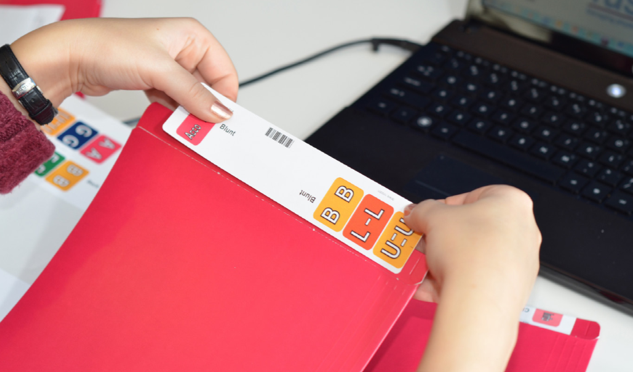Sponsored Content

All-in-one strip labels: No more individual alpha and numeric labels
Many filing systems require alpha and numeric labels to identify and sort files. More often than not, this type of system requires each label to be applied individually, taking up valuable time and resources. Do-it-yourself labelling software does away with these inefficiencies by allowing you to print an all-in-one strip label containing all of the required file information. This approach dramatically reduces the amount of time required to apply file labels, increasing the overall efficiency of your file room or office.

All required file information, on a single strip-label, applied in one easy step
Color-coding: Easy on the eye
Color-coding is a simple but amazingly effective tool for organizing physical files. With color-coding, each letter or number in your filing system corresponds to its own standard color. These colors provide visual cues that help workers find files up to 40 percent faster than text alone.
Color-coding is also a simple and reliable way to spot misfiled records. Afile placed in the wrong section of shelving is instantly recognizable as a break in the color pattern. This dramatically reduces misfiles and avoids the inefficiencies of searching for lost records. Labeling software makes it easy to apply a color-coding system that suits your organization’s needs. When a new file is created, you can instantly print a new label with the exact color-coding required.

Can you spot the misfiled record?
Barcoding: More than just tracking
 Access to files can be one of the largest drains on an organization’s resources. Labelling software can solve this challenge by incorporating barcodes into your printed strip labels. Barcodes allow you to easily track the location and movement of individual files and records, saving a lot of time that would otherwise be spent tracking down files. When used consistently, barcoded file systems can mitigate risks associated with lost or misplaced records, and they can be a useful tool in managing your retention schedules. Labelling software makes it easy to create unique barcodes for each of your strip labels, allowing you to reap all of the benefits barcoding has to offer.
Access to files can be one of the largest drains on an organization’s resources. Labelling software can solve this challenge by incorporating barcodes into your printed strip labels. Barcodes allow you to easily track the location and movement of individual files and records, saving a lot of time that would otherwise be spent tracking down files. When used consistently, barcoded file systems can mitigate risks associated with lost or misplaced records, and they can be a useful tool in managing your retention schedules. Labelling software makes it easy to create unique barcodes for each of your strip labels, allowing you to reap all of the benefits barcoding has to offer.
Dynamic labelling: Let the data do the work
Instead of having to read the contents of each file and writing onto each label by hand, file labeling software allows you to automate the file labeling process by tapping into various data sources. For example, data can easily be imported from customer databases to add dynamic information to your file labels with minimal manual labor. As well as making it easier to find and identify a file, the extra data can provide valuable information about the contents of a file, saving workers time and effort when reviewing multiple files.

Multiple dynamic data elements can be used on your labels
Designs: Doing it your way
With some labeling software, designs of your labels can be changed and altered as needed. Different departments are able to print and design new labels to suit their needs. The software can instantly switch between various label designs, allowing your entire organization to print their labels on demand, without having to order in advance. For example, a customer relations department may want labels designed to identify files based on name and year, whereas a legal department needs to easily distinguish between open and closed legal cases, and an insurance department may want to identify which files contain active claims. Labelling software allows each department to create labels to meet their specific needs, on demand, without having to pre-order individual file labels

Easily switch between different designs for different departments
For more information about how labelling software can help your organization, visit us at: tab.com/tabquik


